JESSE JACKSON’S SHOW Suburban Ecologies, installed at the Palm Court Arts Complex at Irvine, California, had an unconventional run from December 6, 2020, to March 14, 2021. As an exhibit, it took as its object the topography and built environment of Orange County and Irvine. The Great Park Art Gallery, which is part of the Palm Court Arts Complex, is one piece of the ambitious and flawed development of the former El Toro Marine Corps Air Station into a sprawling and “innovative” public park and sports complex. Jackson’s show was meant to hold a fractured mirror up to a space — a town and an idea — making viewers contemplate along with the artist the difficulty of framing the contours of this “super suburb,” located between the Orange Coast and the Santa Ana Mountains. The Gallery could never open to the public during the time of the exhibit because of the pandemic, and the city provided instead, a digital walk-through. Elements of Jackson’s show have been reinstalled in Irvine City Hall and opened on August 12, 2021. The great virtue of Jackson’s engagement with the suburban landscape is his refusal to condescend to his subject matter: he does not exhibit the jaded response to Irvine’s built and natural environment, that can be characterized as something like, “It’s so beige and boring. It’s built for normies, not cosmopolitans like me.” In fact, Irvine’s diverse immigrant communities connect it to Middle Eastern, Latin American, Asian, and South Asian diasporas that span the globe. Holding Irvine in contempt for its presumed provincialism, therefore, sorely misses the mark. Jackson, an expat Canadian himself, avoids this trap.
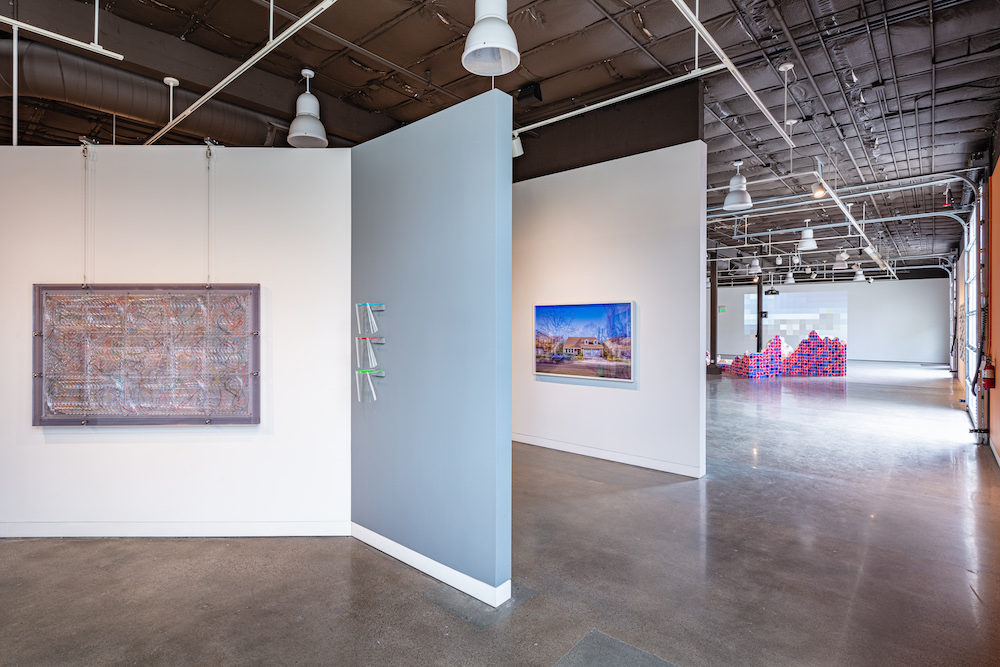
The show, although ostensibly about water and the Santa Ana River around which Irvine has developed is not a typical aesthetic engagement with nature or drought. There are no moments of the natural sublime of the coastal areas of Orange County, captured by tourist imagery, amateur photography, and the traditions of plein air painting. Nor is there a facile condemnation of water wastage by suburb dwellers. Jackson’s work looks at the uniformity and blandness of the built environment and through his superimposition of different photographs of different houses based on the same model homes, he raises a number of fascinating ethical, aesthetic, and political questions. People live in each model of the homes in very different ways, and the superimposition of different photographs taken from the same angle of different homes, Jackson evokes the seriality and repetition of an abstract modernism that the eclectic post-modern architecture of most of the models actually reject. Planned communities produce a highly rationalized landscape, and easily mass-produced housing on an unimaginable scale, but can they address the human need for randomness, chance encounters, and non-ends-oriented visual or aesthetic experience?
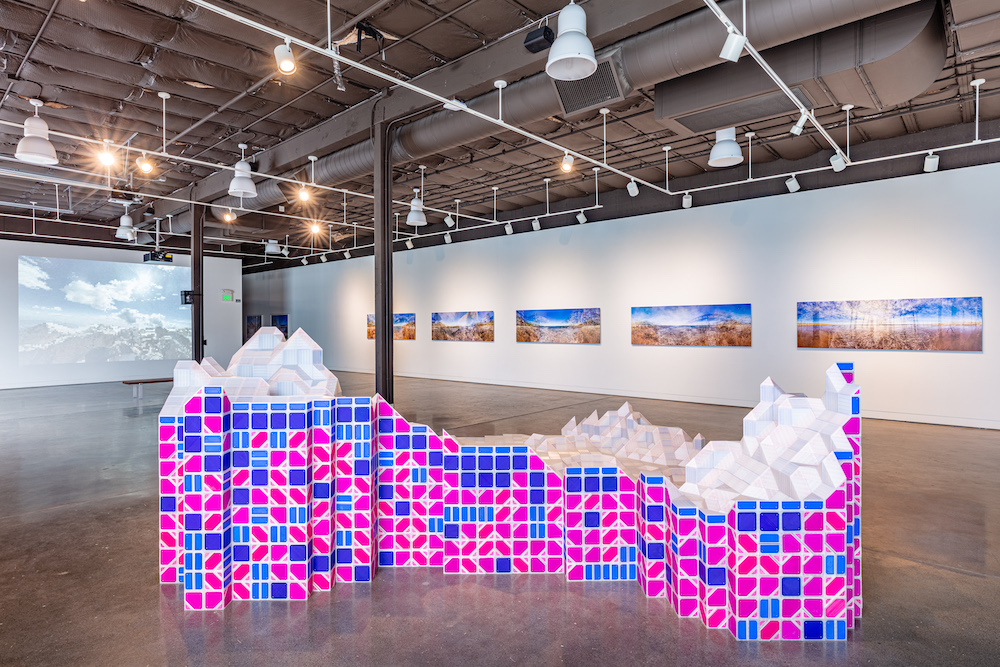
The exhibition comprised four major components: 1) a series of panoramic photo composite images taken by the artist as he walked the Orange County coastline, 2) a series of large photo composite images of emblematic house models in Irvine’s various “villages,” 3) three-dimensional printed cubes that were arranged to model Irvine’s watershed topography, and finally, 4) two video projections of footage shot by Jackson while biking and hiking from sea level to Irvine’s highest peaks. The projections varied in degree of definition, with one video that looked like a home movie made in Minecraft. The video’s low resolution made the artist’s journey from seaside to peak barely recognizable. Jackson’s 3-D printed cubes have the same primitive, toy-like quality of the Minecraft world: arranged as a topographical map of the Santa Ana River watershed area, the cubes try to make recognizable a landscape that has been thoroughly terraformed by the ambitions of the Irvine Company. The Irvine Water District participates in these ambitions, having created one of the most advanced gray water recycling systems in the world. The cubes were part of Jackson’s art and engineering project involving 3-D printed modular building blocks out of which he has created a number of sculptures, installations, and performances. The presence of the water infrastructure of the city and the Santa Ana River are only implied and abstracted in the work. Water, the precious commodity in a time of drought, has no physical, auditory, or color presence in this work. The Santa Ana River shapes the Irvine valley, but its power and presence are implied rather than represented.
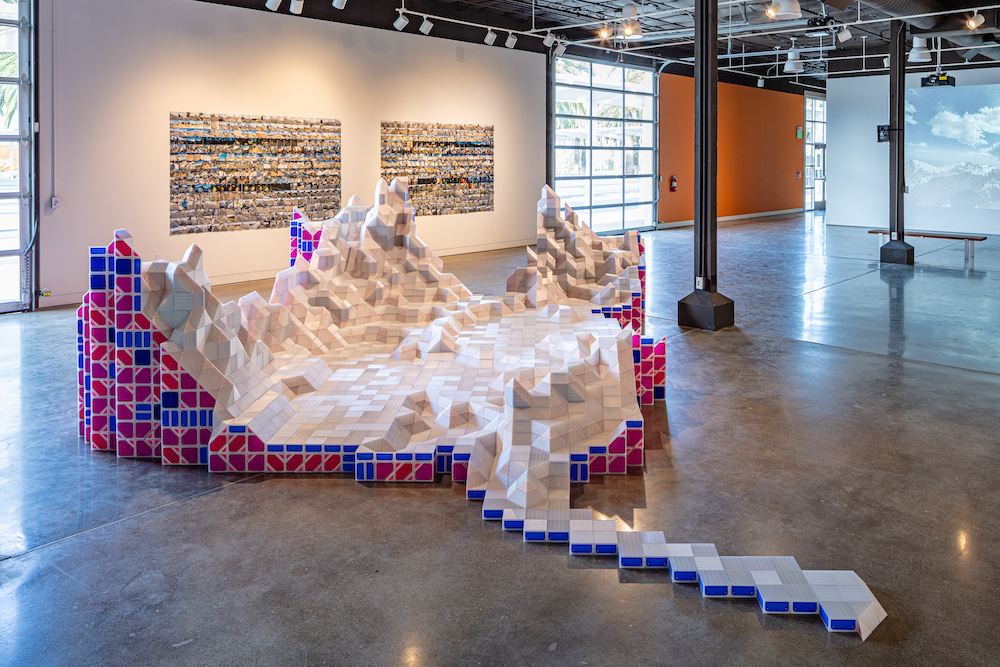
Since Irvine is Jackson’s object of contemplation, a bit about the history of Irvine’s architectural development is in order. Irvine is a “super suburb,” which means that it was developed with upper-tier homeowners in mind. The city is anchored by the University of California (where both Jesse Jackson and I teach). Irvine is a more ethnically and racially integrated city than Los Angeles. (White Angelenos of means have fled the public school system whereas Irvine’s suburban schools are an attraction to families of all races and ethnicities that can afford the elevated real estate prices. Economic uniformity and ethnic and racial diversity seem to be distinguishing features of the new suburbia.) The city was planned in the mid-20th century as a Professional Managerial Class Utopia. Such projects had more aesthetic and political progressive appeal because economically redistributive policies and investment in public institutions were popular policies in Cold War America. In 1965, when ground was broken at the University of California, Irvine, the top income tax rate was 70 percent. Today, the city reflects the technocratic ideal: it maximizes real estate and retail space for profit while offering white-collar workers a safe and predictable environment in which to raise their children. Irvine has nothing exotic or fanciful about it, except perhaps for the stories of immigrant struggle, success, and survival contained by its earth-toned stucco walls.
The contemporary contours of Irvine’s Master Plan has thus left artists like Jackson, who was also trained as an architect, scratching their heads about a place where every facade, every color of every home model, every strip mall, every sidewalk, every leaf, every bush, every drop of water at a time of drought can be accounted for and managed. In the original Master Plan, dating back to Irvine’s founding in 1971, the city was designed as a series of “villages,” each featuring single family homes and walkable amenities. As architectural historian Alan Hess, who lives in Irvine, has pointed out, University Park — the first “village” built in the early 1970s — featured visionary post and beam ranches and midcentury modern homes built around green spaces that maximized a sense of intimacy with nature and neighbors. The original villages emphasized social conviviality in their design. By the time Donald Bren took over the Irvine Company in 1983, the architectural aspirations of the original Master Plan had been discarded in favor of Spanish colonial pastiche and gave rise to virtually gated communities featuring little to no green space, lots of blank white walls, and homes turned willfully away from the “street.” The city has responded to the economic and architectural trends of every decade, incorporating modernist, post-modernist, and contextualist imprints within architecturally uniform communities that stretch to the foothills of the Santa Ana Mountains. The developments have remained consistent in providing every community with many amenities including swimming pools, tennis courts, and parks. The Irvine Company now competes with another real estate development company, FivePoint, presently developing denser, contemporary homes in the open land around the Great Park.
As much as Jackson’s project looks at the city and its land from the point of view of a cyclist, a hiker, and a still photographer, the only way he can process its topography and built environment is through technological abstraction. The viewer is asked to identify with his struggle to put the human figure or eye in the landscape he tries to document. And as he walks the coast to photograph it and takes multiple stills of the different versions of the same house model and superimposes them to produce massive photoprints that are like documents of a cyborg, unblinking insect’s gaze, he cannot quite come to terms with the social and architectural whole of a place that has sheltered some of Southern California’s most successful professional communities while promoting the forbidding neofeudal economic divisions created by soaring real estate prices that make the area’s economic segregation and exclusion seem as completely intractable as the mountains that overlook Irvine valley.
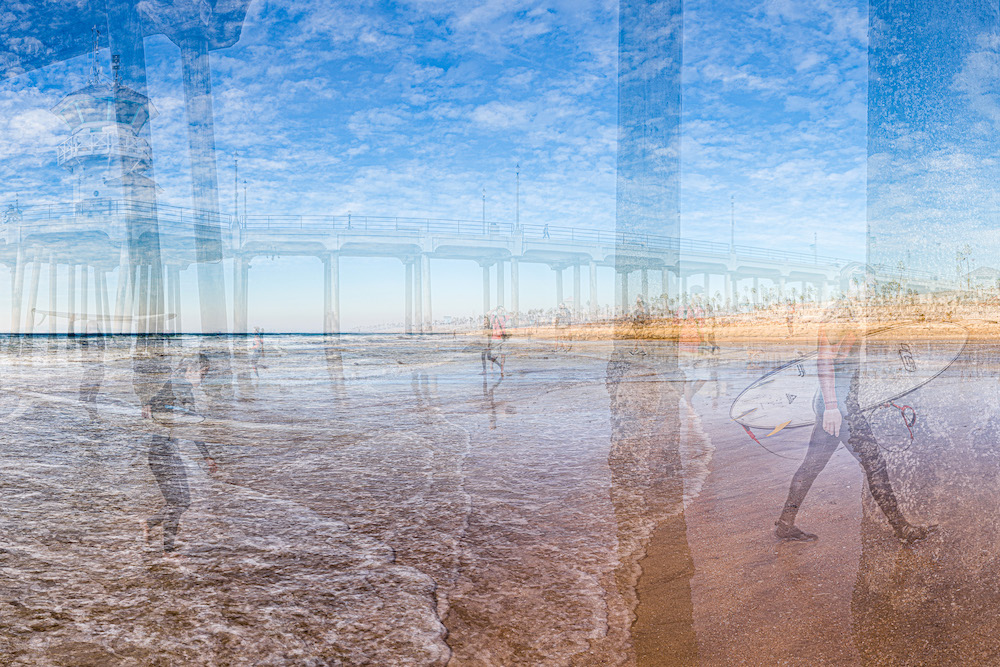
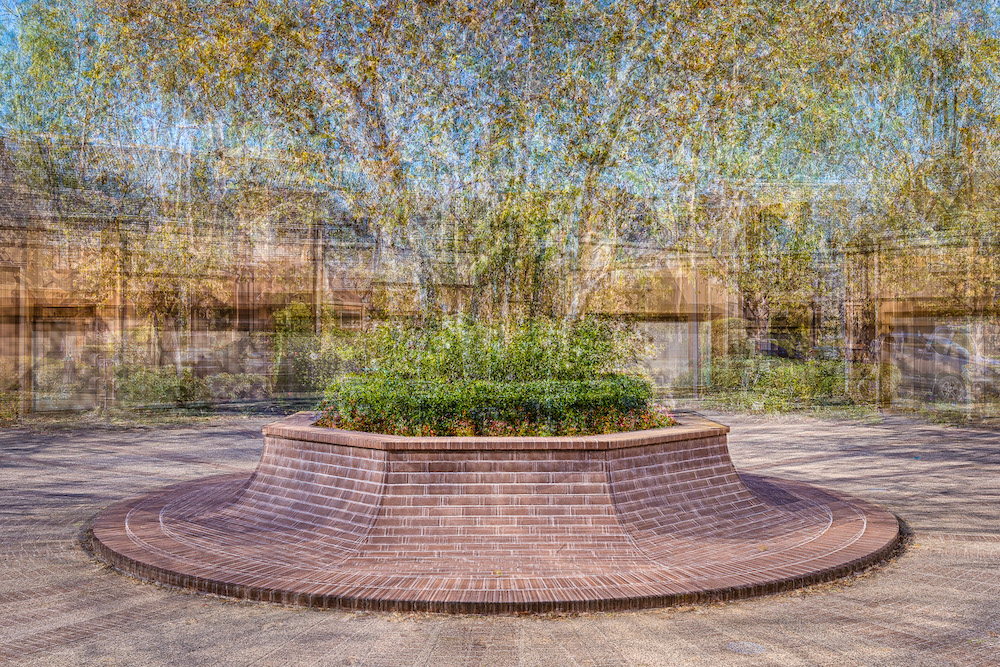
After his show closed before California loosened its COVID-19 restrictions, Jackson reinstalled parts of Suburban Ecologies at Irvine City Hall. His work looks great in the halls and the atrium of the 1990s post-modernist building. Outside of the Great Park Art Gallery, the composite photographs respond well against drywall and textured beige brick. They are lit in an intimate way. Allegedly, the city government loves having contemporary art around. Under Mayor Farrah Khan, who reversed the Tea Party/CPAC-friendly course of her Republican predecessor Don Wagner, Irvine has become a place that is more open to progressive politics and a liberal cultural program. It is, however, a place still struggling to come to terms with its cultural and social identity. Its open spaces and valuable housing stock have been repurposed for immigrant communities, but Jackson’s show does not address the dramatic demographic shifts that have been taking place in the city. In 1980, non-Hispanic whites made up 85 percent of Irvine’s population. In 2010, they made up only 45.1 percent of the total population of the city. Today, in 2021 that number has probably declined even further. The greatest increase in minority population is Asian American. Economic uniformity and homogeneity remain unchanged, and the divergence between Irvine and neighboring cities with large Hispanic populations like Santa Ana and Anaheim is greater than ever.
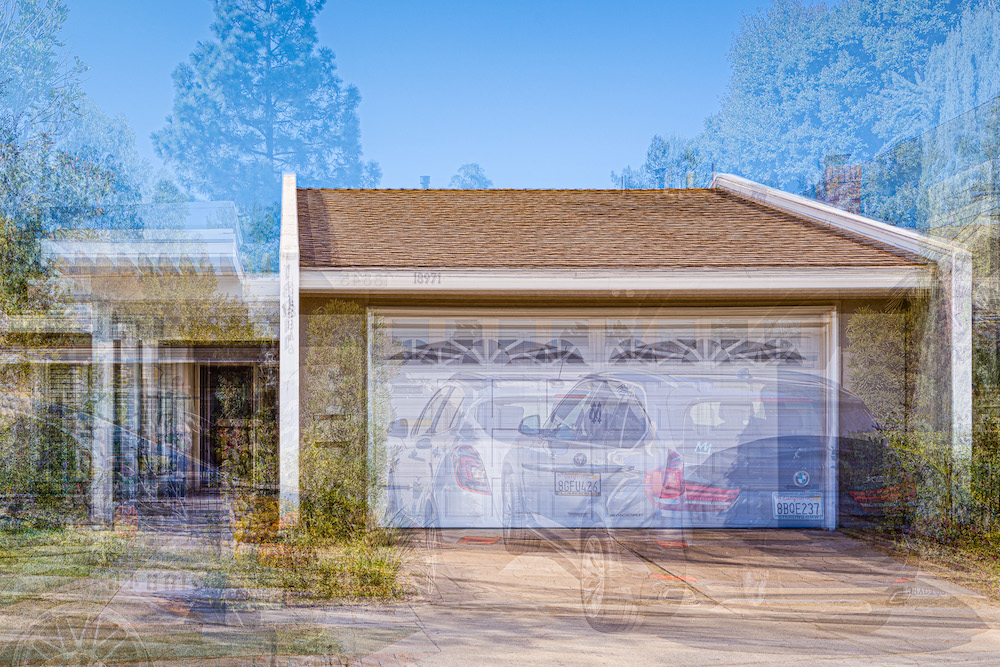
In the composite photographs of Irvine homes, Jackson photographs different versions of the same model home with stunning consistency, from exactly the same angle and position relative to each house so that the houses are perfectly superimposed on each other. Repeated elements like the perennially blue sky become extra vivid, while the varying details of each home, from different cars in the driveway, to palm trees and landscaping, to wind chimes, to an occasional human figure carrying groceries in a driveway, take on a ghostly, ethereal quality. Jackson’s work does not present the Orange Coast or the subdivision housing in a way that is easy to grasp: in the large composite photographs of the coast, the waterline can appear beautiful, but the eye cannot rest on the horizon. Too many obtrusive details like spectral chain link fencing, pier pylons, surfers, and sunbathers interrupt the facile contemplation of beach and seascape.
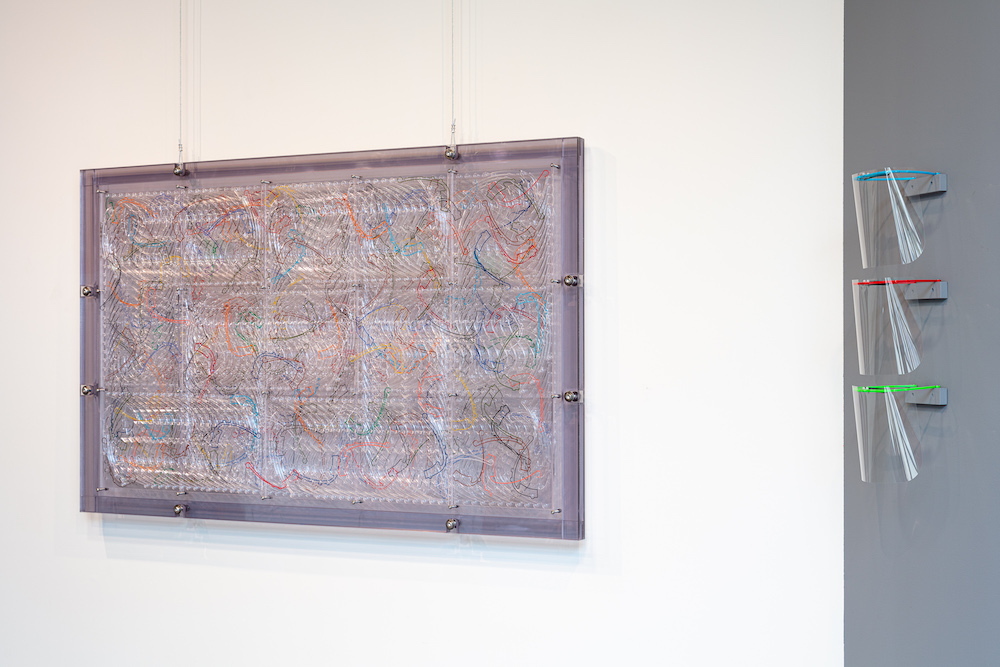
Lest Jackson’s work seem too abstract, playful, or pointless to a skeptical viewer, the exhibit included a piece called Five Thousand Faces, a suspended wall panel of Lucite encasing the colorful die cut plastic discards from Jackson’s 2020 face shield production project. In the earliest days of the pandemic, he and a group of UCI students used the artist’s 3-D printers to make 20,000 faces shields for University of California, Irvine Medical Center. Five Thousand Faces has nothing to do with the visual and aesthetic questions raised by the rest of the work. Its inclusion is meant to reassure STEM-, business-, and engineering-oriented but curious viewers, or the majority of Irvine’s residents, that artists can be put to work to create useful things like personal protective equipment. The inclusion of this hanging panel is a reminder that the artist and curator of the show decided that Irvine is not ready for the disturbing and often anxiety-producing questions raised by art and the aesthetic experience; Five Thousand Faces shows no human face, but reminds or reassures the viewer of the utility of an artist’s activities. The utilitarianism of Five Thousand Faces might be an ironic allusion to the philosophy of Jeremy Bentham, who believed that through good planning and design, architects, engineers, and philosophers should promote policies and ideas that maximize happiness for the largest numbers of people. If Disneyland is known as the happiest place on earth, can Irvine also make that kind of claim, or does its forbidding planned uniformity and high real estate prices exacerbate the economic, political, and scientific anxiety of a suburban world, built to maximize happiness in a time of political instability, intensifying inequality, and environmental and biological threats that we haven’t even identified yet? The provocative aesthetic and visual elements of Jackson’s show, then, push us to ponder the ideals embodied by any Master Plan, and the dangers that it almost inevitably courts.
Catherine Liu is most recently author of Virtue Hoarders: the Case Against the Professional Managerial Class (University of Minnesota Press, 2021). Author of two academic monographs, Copying Machines: Taking Notes for the Automaton and American Idyll: Academic Anti-Elitism as Cultural Critique, she has also published a novel called Oriental Girls Desire Romance. She is working on a memoir, titled Panda Gifts.

The show, although ostensibly about water and the Santa Ana River around which Irvine has developed is not a typical aesthetic engagement with nature or drought. There are no moments of the natural sublime of the coastal areas of Orange County, captured by tourist imagery, amateur photography, and the traditions of plein air painting. Nor is there a facile condemnation of water wastage by suburb dwellers. Jackson’s work looks at the uniformity and blandness of the built environment and through his superimposition of different photographs of different houses based on the same model homes, he raises a number of fascinating ethical, aesthetic, and political questions. People live in each model of the homes in very different ways, and the superimposition of different photographs taken from the same angle of different homes, Jackson evokes the seriality and repetition of an abstract modernism that the eclectic post-modern architecture of most of the models actually reject. Planned communities produce a highly rationalized landscape, and easily mass-produced housing on an unimaginable scale, but can they address the human need for randomness, chance encounters, and non-ends-oriented visual or aesthetic experience?

The exhibition comprised four major components: 1) a series of panoramic photo composite images taken by the artist as he walked the Orange County coastline, 2) a series of large photo composite images of emblematic house models in Irvine’s various “villages,” 3) three-dimensional printed cubes that were arranged to model Irvine’s watershed topography, and finally, 4) two video projections of footage shot by Jackson while biking and hiking from sea level to Irvine’s highest peaks. The projections varied in degree of definition, with one video that looked like a home movie made in Minecraft. The video’s low resolution made the artist’s journey from seaside to peak barely recognizable. Jackson’s 3-D printed cubes have the same primitive, toy-like quality of the Minecraft world: arranged as a topographical map of the Santa Ana River watershed area, the cubes try to make recognizable a landscape that has been thoroughly terraformed by the ambitions of the Irvine Company. The Irvine Water District participates in these ambitions, having created one of the most advanced gray water recycling systems in the world. The cubes were part of Jackson’s art and engineering project involving 3-D printed modular building blocks out of which he has created a number of sculptures, installations, and performances. The presence of the water infrastructure of the city and the Santa Ana River are only implied and abstracted in the work. Water, the precious commodity in a time of drought, has no physical, auditory, or color presence in this work. The Santa Ana River shapes the Irvine valley, but its power and presence are implied rather than represented.

Since Irvine is Jackson’s object of contemplation, a bit about the history of Irvine’s architectural development is in order. Irvine is a “super suburb,” which means that it was developed with upper-tier homeowners in mind. The city is anchored by the University of California (where both Jesse Jackson and I teach). Irvine is a more ethnically and racially integrated city than Los Angeles. (White Angelenos of means have fled the public school system whereas Irvine’s suburban schools are an attraction to families of all races and ethnicities that can afford the elevated real estate prices. Economic uniformity and ethnic and racial diversity seem to be distinguishing features of the new suburbia.) The city was planned in the mid-20th century as a Professional Managerial Class Utopia. Such projects had more aesthetic and political progressive appeal because economically redistributive policies and investment in public institutions were popular policies in Cold War America. In 1965, when ground was broken at the University of California, Irvine, the top income tax rate was 70 percent. Today, the city reflects the technocratic ideal: it maximizes real estate and retail space for profit while offering white-collar workers a safe and predictable environment in which to raise their children. Irvine has nothing exotic or fanciful about it, except perhaps for the stories of immigrant struggle, success, and survival contained by its earth-toned stucco walls.
The contemporary contours of Irvine’s Master Plan has thus left artists like Jackson, who was also trained as an architect, scratching their heads about a place where every facade, every color of every home model, every strip mall, every sidewalk, every leaf, every bush, every drop of water at a time of drought can be accounted for and managed. In the original Master Plan, dating back to Irvine’s founding in 1971, the city was designed as a series of “villages,” each featuring single family homes and walkable amenities. As architectural historian Alan Hess, who lives in Irvine, has pointed out, University Park — the first “village” built in the early 1970s — featured visionary post and beam ranches and midcentury modern homes built around green spaces that maximized a sense of intimacy with nature and neighbors. The original villages emphasized social conviviality in their design. By the time Donald Bren took over the Irvine Company in 1983, the architectural aspirations of the original Master Plan had been discarded in favor of Spanish colonial pastiche and gave rise to virtually gated communities featuring little to no green space, lots of blank white walls, and homes turned willfully away from the “street.” The city has responded to the economic and architectural trends of every decade, incorporating modernist, post-modernist, and contextualist imprints within architecturally uniform communities that stretch to the foothills of the Santa Ana Mountains. The developments have remained consistent in providing every community with many amenities including swimming pools, tennis courts, and parks. The Irvine Company now competes with another real estate development company, FivePoint, presently developing denser, contemporary homes in the open land around the Great Park.
As much as Jackson’s project looks at the city and its land from the point of view of a cyclist, a hiker, and a still photographer, the only way he can process its topography and built environment is through technological abstraction. The viewer is asked to identify with his struggle to put the human figure or eye in the landscape he tries to document. And as he walks the coast to photograph it and takes multiple stills of the different versions of the same house model and superimposes them to produce massive photoprints that are like documents of a cyborg, unblinking insect’s gaze, he cannot quite come to terms with the social and architectural whole of a place that has sheltered some of Southern California’s most successful professional communities while promoting the forbidding neofeudal economic divisions created by soaring real estate prices that make the area’s economic segregation and exclusion seem as completely intractable as the mountains that overlook Irvine valley.


After his show closed before California loosened its COVID-19 restrictions, Jackson reinstalled parts of Suburban Ecologies at Irvine City Hall. His work looks great in the halls and the atrium of the 1990s post-modernist building. Outside of the Great Park Art Gallery, the composite photographs respond well against drywall and textured beige brick. They are lit in an intimate way. Allegedly, the city government loves having contemporary art around. Under Mayor Farrah Khan, who reversed the Tea Party/CPAC-friendly course of her Republican predecessor Don Wagner, Irvine has become a place that is more open to progressive politics and a liberal cultural program. It is, however, a place still struggling to come to terms with its cultural and social identity. Its open spaces and valuable housing stock have been repurposed for immigrant communities, but Jackson’s show does not address the dramatic demographic shifts that have been taking place in the city. In 1980, non-Hispanic whites made up 85 percent of Irvine’s population. In 2010, they made up only 45.1 percent of the total population of the city. Today, in 2021 that number has probably declined even further. The greatest increase in minority population is Asian American. Economic uniformity and homogeneity remain unchanged, and the divergence between Irvine and neighboring cities with large Hispanic populations like Santa Ana and Anaheim is greater than ever.

In the composite photographs of Irvine homes, Jackson photographs different versions of the same model home with stunning consistency, from exactly the same angle and position relative to each house so that the houses are perfectly superimposed on each other. Repeated elements like the perennially blue sky become extra vivid, while the varying details of each home, from different cars in the driveway, to palm trees and landscaping, to wind chimes, to an occasional human figure carrying groceries in a driveway, take on a ghostly, ethereal quality. Jackson’s work does not present the Orange Coast or the subdivision housing in a way that is easy to grasp: in the large composite photographs of the coast, the waterline can appear beautiful, but the eye cannot rest on the horizon. Too many obtrusive details like spectral chain link fencing, pier pylons, surfers, and sunbathers interrupt the facile contemplation of beach and seascape.

Lest Jackson’s work seem too abstract, playful, or pointless to a skeptical viewer, the exhibit included a piece called Five Thousand Faces, a suspended wall panel of Lucite encasing the colorful die cut plastic discards from Jackson’s 2020 face shield production project. In the earliest days of the pandemic, he and a group of UCI students used the artist’s 3-D printers to make 20,000 faces shields for University of California, Irvine Medical Center. Five Thousand Faces has nothing to do with the visual and aesthetic questions raised by the rest of the work. Its inclusion is meant to reassure STEM-, business-, and engineering-oriented but curious viewers, or the majority of Irvine’s residents, that artists can be put to work to create useful things like personal protective equipment. The inclusion of this hanging panel is a reminder that the artist and curator of the show decided that Irvine is not ready for the disturbing and often anxiety-producing questions raised by art and the aesthetic experience; Five Thousand Faces shows no human face, but reminds or reassures the viewer of the utility of an artist’s activities. The utilitarianism of Five Thousand Faces might be an ironic allusion to the philosophy of Jeremy Bentham, who believed that through good planning and design, architects, engineers, and philosophers should promote policies and ideas that maximize happiness for the largest numbers of people. If Disneyland is known as the happiest place on earth, can Irvine also make that kind of claim, or does its forbidding planned uniformity and high real estate prices exacerbate the economic, political, and scientific anxiety of a suburban world, built to maximize happiness in a time of political instability, intensifying inequality, and environmental and biological threats that we haven’t even identified yet? The provocative aesthetic and visual elements of Jackson’s show, then, push us to ponder the ideals embodied by any Master Plan, and the dangers that it almost inevitably courts.
¤
Catherine Liu is most recently author of Virtue Hoarders: the Case Against the Professional Managerial Class (University of Minnesota Press, 2021). Author of two academic monographs, Copying Machines: Taking Notes for the Automaton and American Idyll: Academic Anti-Elitism as Cultural Critique, she has also published a novel called Oriental Girls Desire Romance. She is working on a memoir, titled Panda Gifts.
LARB Contributor
Catherine Liu is most recently author of Virtue Hoarders: the Case Against the Professional Managerial Class (University of Minnesota Press, 2021). Author of two academic monographs, Copying Machines: Taking Notes for the Automaton and American Idyll: Academic Anti-Elitism as Cultural Critique, she has also published a novel called Oriental Girls Desire Romance. President of the Western Humanities Alliance, she edited a special issue of the Western Humanities Review (2016) on the topic of Prestige. She is at work on a memoir called Panda Gifts, and is a contributor to Liza Featherstone's collection False Choices: the Faux Feminism of Hillary Clinton. Her interest in the populist rebellion against the Professional Managerial Class seems to have been redeemed by recent events.
LARB Staff Recommendations
Courtiers and Sycophants: Catherine Liu’s Case Against the Professional Managerial Class
An excoriation of the professional managerial class that strips attention from the people it purports to help.
Another Holy Land
Michael Scott Moore reviews D. J. Waldie's new book, "Becoming Los Angeles: Myth, Memory, and a Sense of Place."
Did you know LARB is a reader-supported nonprofit?
LARB publishes daily without a paywall as part of our mission to make rigorous, incisive, and engaging writing on every aspect of literature, culture, and the arts freely accessible to the public. Help us continue this work with your tax-deductible donation today!
:quality(75)/https%3A%2F%2Fdev.lareviewofbooks.org%2Fwp-content%2Fuploads%2F2021%2F09%2Fliujackson.jpg)